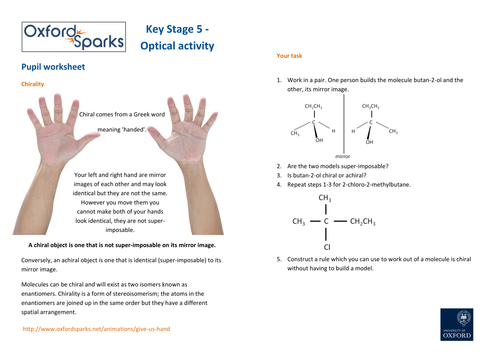





Chirality can be seen in many objects, from galaxies to flowers, and from foods to medicine. This activity is an ideal way to introduce the concept of chirality and optical isomerism. The video 'Give us a hand' outlines basic information. During the lesson students learn to recognise chiral molecules and then witness a demonstration to see how plane polarised light is rotated in different directions by enantiomers of carvone. Finally, they apply their knowledge by explaining how the observed angle of rotation can be measured using a polarimeter. In an optional extra activity they can watch a video demonstration, and then use a homemade polarimeter to work out the specific rotation of carvone.
Learning outcomes: 1) Define the terms chirality, enantiomer, optical isomer, polarised light; 2) Identify examples of chiral molecules; 3) Explain why chiral molecules are described as optically active.
See more at http://www.oxfordsparks.net/learning-resources#2162
Learning outcomes: 1) Define the terms chirality, enantiomer, optical isomer, polarised light; 2) Identify examples of chiral molecules; 3) Explain why chiral molecules are described as optically active.
See more at http://www.oxfordsparks.net/learning-resources#2162
Something went wrong, please try again later.
Just what I was looking for, thanks for sharing and for free
Amazing - Thank you so much!
Its so hard to find decent Y13 resources and this is excellent!!!!
Report this resourceto let us know if it violates our terms and conditions.
Our customer service team will review your report and will be in touch.
£0.00
